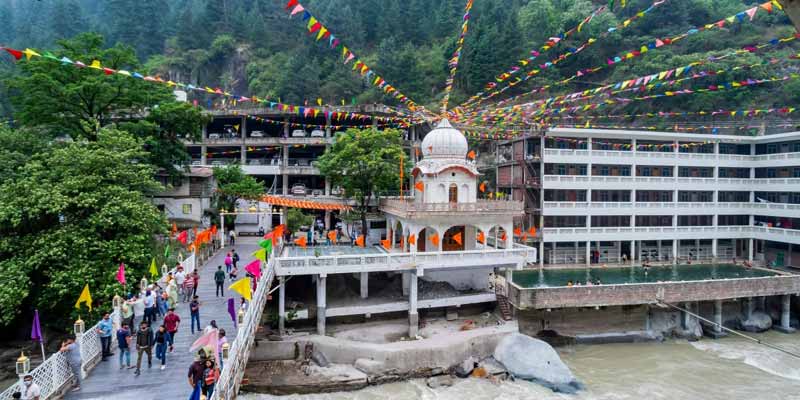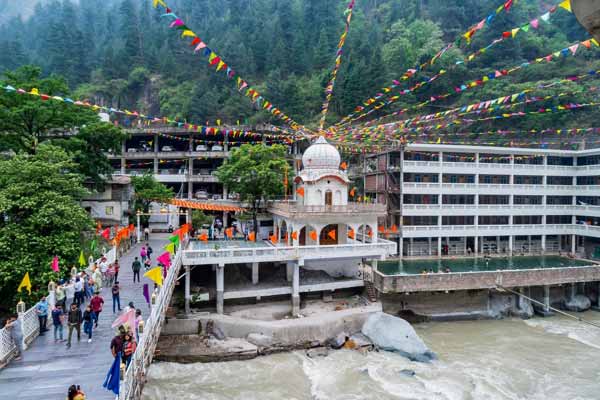Manikaran Shiva Temple Manali is a revered Hindu shrine nestled in the serene landscapes of Manali, India. Situated amidst the majestic Himalayas, this temple holds immense religious significance and historical importance.
Dedicated to Lord Shiva, the temple attracts devotees and tourists alike, drawn not only by its religious aura but also by the stunning natural beauty that surrounds it. The temple complex is adorned with intricate architecture, reflecting ancient design elements and spiritual motifs.
One of the most captivating features of this sacred site is the natural hot springs that flow nearby. These geothermal springs are believed to have therapeutic properties and are an integral part of the religious rituals performed at the temple. Visitors often take a dip in these hot springs seeking spiritual purification and the believed healing benefits of the mineral-rich waters Manali Attractions.
The serene ambiance, coupled with the spiritual aura, creates an atmosphere of tranquility and devotion. Pilgrims flock here to seek blessings, perform rituals, and immerse themselves in the divine presence of Lord Shiva.
The Manikaran Shiva Temple stands not just as a religious edifice but also as a testament to the fusion of spirituality and nature’s wonder, making it a must-visit destination for those seeking both inner peace and cultural exploration amidst the breathtaking landscapes of Manali Tour Packages.

Manikaran Shiva Temple History
The history of the Manikaran Shiva Temple in Manali, India, dates back centuries, steeped in mythology and tales of divine significance. Legend has it that Lord Shiva and Goddess Parvati once chose this tranquil place as their abode.
According to Hindu mythology, after their marriage, Lord Shiva and Goddess Parvati visited this region. As Parvati dropped her earring (“Mani” in Sanskrit) into the waters of the Parvati River, Shiva summoned his serpent deity, Sheshnag, to retrieve it. When the serpent couldn’t find the earring, Shiva was pleased by the serpent’s efforts and blessings were bestowed upon the area. It’s believed that the earring emerged from the ground, resulting in the emergence of the hot springs and earning the place its name—Manikaran.
Over time, the spot gained immense religious significance for Hindu devotees. The temple dedicated to Lord Shiva was subsequently built, becoming a focal point for pilgrims and seekers of spiritual enlightenment.
The architecture of the temple showcases traditional Hindu design elements, reflecting the cultural and historical heritage of the region. Its serene location amidst the Himalayas adds to its allure, attracting not only religious pilgrims but also tourists seeking a blend of spirituality and natural beauty.
The natural hot springs adjacent to the temple have their own historical and religious importance. They are considered sacred and are believed to have healing properties, drawing visitors who seek both spiritual blessings and physical rejuvenation.
Throughout the ages, the Manikaran Shiva Temple has stood as a symbol of devotion and faith, preserving the ancient legends and traditions that continue to captivate devotees and visitors alike. Its rich history, coupled with the awe-inspiring surroundings, makes it a place of reverence and wonder in the heart of Manali Tourism.
Manikaran Temple Timings
For those planning a visit to the Manikaran Shiva Temple, it’s crucial to be mindful of the temple’s timings. The temple follows a daily schedule that accommodates both early morning worshippers seeking spiritual solace and those wanting to witness the evening aarti, a mesmerizing ritual of offering prayers through the medium of light.
Morning Darshan:
- The temple opens its doors to devotees at the break of dawn.
- Morning aarti, a ritualistic prayer, is performed to commence the day on a divine note.
- Pilgrims can experience the tranquil ambiance and offer their prayers during the morning hours.
Afternoon Break:
- The temple takes a brief pause during the afternoon to allow for maintenance and preparation for the evening rituals.
- Devotees can explore the surrounding area, including the hot springs and the mesmerizing Parvati River.
Evening Aarti:
- As the sun begins its descent, the evening aarti takes place, captivating visitors with its spiritual resonance.
- The temple resonates with the sounds of chants, bells, and the rhythmic clanging of cymbals during this sacred ceremony.
- The evening aarti is a must-attend, offering a soul-stirring experience that lingers in the hearts of those who witness it.
Best time to visit Manikaran Shiva Temple
The Manikaran Shiva Temple in Manali, India, can be visited throughout the year, but the best time for a visit may depend on personal preferences and the experiences one seeks.
The months from March to June mark the summer season in Manali. During this time, the weather remains pleasant and comfortable, making it an ideal period for temple visits and sightseeing. The temperatures are moderate, ranging from around 10°C to 25°C (50°F to 77°F), and the surroundings are lush and vibrant due to the blooming flora. This season attracts a significant number of tourists, so expect more crowds at the temple and nearby attractions.
Another favorable time to visit is during the autumn months from September to November. The weather during this period is mild, and the landscapes are adorned with beautiful autumn foliage, creating a picturesque setting for a spiritual visit to the temple.
However, it’s important to note that Manikaran experiences heavy rainfall during the monsoon season from July to August. While the rainfall adds to the scenic beauty of the region, it might make travel inconvenient due to landslides or slippery pathways, so this season might not be the most suitable for visiting the temple.
Winter (December to February) brings snowfall to the region, transforming Manali into a winter wonderland. While the scenery is breathtaking, the cold weather and snowfall might make travel challenging, especially to higher altitude areas.
Ultimately, the best time to visit the Manikaran Shiva Temple depends on individual preferences, whether one prefers pleasant weather, fewer crowds, or specific seasonal experiences. It’s recommended to check weather forecasts and plan accordingly to ensure a comfortable and enjoyable visit to this sacred site.
How to Reach Manikaran Temple
Reaching the Manikaran Shiva Temple in Manali involves various transportation options owing to its location amidst the Himalayas. Here are several ways to reach the temple:
By Air: The nearest airport is Bhuntar Airport, about 31 kilometers away from Manikaran. From the airport, you can hire a taxi or use local transportation to reach Manikaran.
By Road: Manali is well-connected by road. Visitors can reach Manali by bus or private vehicle from nearby cities like Delhi, Chandigarh, or Shimla. From Manali, you can hire a taxi or use local buses to travel to Manikaran.
By Train: The nearest major railway station is Chandigarh Railway Station. From there, you can either take a bus or hire a taxi to reach Manikaran. Joginder Nagar Railway Station is closer but has limited connectivity.
Local Transport: Once in Manikaran, the temple is easily accessible by local transportation options like taxis, auto-rickshaws, or even by walking, depending on where you’re staying in the area.
The journey to Manikaran from Manali or nearby areas is scenic but involves mountainous terrain. It’s advisable to check weather conditions, especially during winter, as snowfall might affect road accessibility. Additionally, road conditions may vary, so it’s wise to plan the journey accordingly and consider any advisories or travel alerts at the time of your visit.
